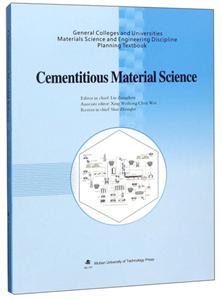-
>
湖南省志(1978-2002)?铁路志
-
>
公路车宝典(ZINN的公路车维修与保养秘籍)
-
>
晶体管电路设计(下)
-
>
无头案:雍正暴亡之谜
-
>
基于个性化设计策略的智能交通系统关键技术
-
>
花样百出:贵州少数民族图案填色
-
>
识木:全球220种木材图鉴
胶凝材料学(英文版) CEMENTITIOUS MATERIALS SCIENCE 版权信息
- ISBN:9787562958796
- 条形码:9787562958796 ; 978-7-5629-5879-6
- 装帧:一般胶版纸
- 册数:暂无
- 重量:暂无
- 所属分类:>>
胶凝材料学(英文版) CEMENTITIOUS MATERIALS SCIENCE 内容简介
本书为新材料科学前沿研究丛书。为普通高等学校材料科学与工程学科规划教材,以通用硅酸盐水泥为主,按品种阐述各类胶凝材料的组成、结构与性能的关系,介绍了胶凝材料的水化硬化机理以及改善硬化体结构与性能的途径。对石膏、石灰、镁质胶凝材料的生产和应用技术,以及混合材料的组成、特性等也做了详细介绍。 本书除作为高等学校无机非金属材料专业、建筑工程材料与制品专业本科教学用书教材外,还可供从事建筑工程与建筑材料工业的有关科研、设计与工程技术人员参考。
胶凝材料学(英文版) CEMENTITIOUS MATERIALS SCIENCE 目录
Chapter 0 Introduction
0.1 Definition and Classification of Cementitious Materials
0.2 The Role of Cementitious Materials in National Economy
0.3 The Brief History of Cementitious Materials
0.4 The Development of Cementitious Materials Science
Chapter 1 Common Portland Cement
1.1 The Invention and Production of Cement
1.1.1 The Invention of Cement
1.1.2 The Process of Cement
1.2 Composition of Portland Cement Clinker
1.2.1 Chemical and Mineral Composition of Clinker
1.2.2 Modulus Value of Clinker
1.2.3 Calculation and Conversion of Mineral Composition of Clinker
1.3 Raw Materials and Raw Materials Proportioning of Portland Cement
1.3.1 Raw Materials of Cement
1.3.2 Clinker Composition Design
1.3.3 Proportioning Calculation of Raw Materials
1.4 Calcination of Portland Cement Clinker
1.4.1 Drying and Dehydration
1.4.2 Decomposition of Carbonate
1.4.3 Solid phase Reaction
1.4.4 Calcination of Clinker
1.4.5 Clinker Cooling
1.4.6 The Role of Other Components
1.4.7 Main Equipments for Clinker Calcination
1.5 Production and Standards for Common Portland Cement
1.5.1 Cement Admixture
1.5.2 Definition, Classification and Specifications for Common Portland Cement
1.5.3 Portland Limestone Cement
1.5.4 Grinding of Cement
1.6 Hydration and Hardening of General Purpose Portland Cemente
1.6.1 Hydration of Cement Clinkers
1.6.2 Hydration of Portland cement
1.6.3 Hydration and Hardening of Portland Cement with
Supplementary Cementitious Materials
1.6.4 Hydration Rate
1.6.5 Hardened Cement Paste
1.7 Properties of Ordinary Portland Cement
1.7.1 Density
1.7.2 Fineness
1.7.3 Water Demand (Consistency, Fluidity)
1.7.4 Setting Time
1.7.5 Strength
1.7.6 Volume Change
1.7.7 Water Retention and Bleeding
1.7.8 Hydration Heat
1.7.9 Heat Resistance
1.7.10 Permeability Resistance
1.7.11 Frost Resistance
1.7.12 Erosion Resistance
Problems
Chapter 2 Characteristic Cements and Special Cement
2.1 Aluminate and High-temperature Resistant Cement
2.1.1 Aluminate Cement
2.1.2 Refractory Castable of Phosphoric Acid and Phosphate
2.1.3 Refractory Castable of Water Glass
2.2 Fast Hardening and High Strength Cement
2.2.1 Fast Hardening Portland Cement
2.2.2 Fast Hardening Sulphoaluminate Cement
2.2.3 Fast Hardening Aluminoferrite Cement
2.2.4 Rapid Hardening Fluoroaluminate Cement
2.2.5 Rapid Hardening and High Strength Aluminate Cement
2.2.6 Super-fast Hardening and Adjustable Setting Aluminate Cement
2.2.7 Special High-strength Cement
2.3 Sulfate-resistant Cement, Moderate Heat and Low Heat Cement and Roads Cement
2.3.1 Sulfate-resistant Cement
2.3.2 Moderate- and Low-heat Portland Cement
2.3.3 Low Heat and Micro Expanding Cement
2.3.4 Low Heat Slag Portland Cement
2.3.5 Road Portland Cement
2.3.6 Steel Slag Cement for Pavement
2.4 Expansive and Self-stressing Cements
2.4.1 Basic Principle of Expansive Cement Production
2.4.2 Types of Expansive Cement
2.4.3 Production Processes and properties
2.5 Oil Well Cement
2.6 Decoration Cement
2.6.1 White Portland Cement
2.6.2 Color Cement
2.7 Masonry Cement
2.7.1 Chinese Standards for Masonry Cement
2.7.2 Industrial Standards for Steel Slag Masonry Cement
2.8 Radiation-proof Cement
2.8.1 Barium Cement
2.8.2 Boron Containing Cement
2.8.3 Strontium Cement
2.8.4 Conducting and Magnetic Cement
2.8.5 Non-magnetic Cement
2.9 Acid-proof Cement
2.9.1 Water Glass Acid-proof Cement
2.9.2 Sulfurous Acid-proof Cement
2.9.3 Polymer Acid-proof Cement
2.10 Low Alkalinity Sulphoaluminate Cement
Problems
Chapter 3 Gypsum
3.1 Raw Materials for Production of Gypsum
3.1.1 Natural Gypsum
3.1.2 Industrial Byproduct Gypsums
3.2 Production of Gypsum Cementitious Materials
3.2.1 Dehydration Transformation of Gypsum
3.2.2 Preparation of Hemihydrate Gypsum
3.3 Building Gypsum
3.3.1 Production of Building Gypsum
3.3.2 Performance and Influencing Factors of Building Gypsum
3.4 Hydration and Hardening Process of I-Iemihydrate Gypsum
3.4.1 Hydration of Gypsum Cementitious Materials
3.4.2 Hydration and Mechanism of Setting and Hardening of Dehydrated Phases
3.4.3 Factors Influence Hydration of Hemihydrate Gypsum
3.4.4 Hardening of Gypsum Paste
3.5 Activation of Auhydrite and Tts Applications
3.5.1 Activation Methods of Anhydrite
3.5.2 Anhydrite Cementing Materials
3.6 Structure and Properties of Hardened Gypsum Paste
3.6.1 Structure of Hardened Gypsum Paste
3.6.2 Strength of Hardened Gypsum Paste
3.6.3 Water Resistance of Hardened Gypsum Paste
3.7 Applications of Gypsum Cementitious Materials
3.7.1 Gypsum Cementitious Materials
3.7.2 Gypsum Products
3.8 Acceptance Check, Storage and Transportation of Gypsum
Problems
Chapter 4 Lime
4.1 Raw Materials for Production of Lime
4.2 Production of Lime
4.2.1 Calcination of Calcium Carbonate
4.2.2 Types of Lime
4.2.3 Characteristics of Architectural Lime
4.2.4 Technical Specifications for Architectural Lime
4.2.5 Activity of Lime
4.3 Hydration of Lime
4.3.1 Hydration of Lime
4.3.2 Characteristics of Lime Hydration
4.4 Structure Formation of Lime Paste
4.4.1 Dissolving and Dispersing of Lime by Water Action
4.4.2 Setting Structure Formation of Lime Paste
4.4.3 Crystalline Structure Formation of Lime Paste
4.5 Hardening of Lime Paste
4.5.1 Crystallization and Attached Strength by Drying
4.5.2 Carbonization
4.6 Applications of Lime
4.6.1 Manufacture of Architectural Quicklime Powders
4.6.2 Production of Slaked Lime Powder or Slaked Lime Slurry
4.6.3 Preparation of Lime Mortar and Grout
4.6.4 Preparation of Lime Soil and Trinity Mixture Fill
4.6.5 Production of Silicate Products
4.6.6 Manufacture of Carbonized Products
4.7 Acceptance Check, Storage, Safekeeping and Transportation of Lime
Problems
……
Chapter 5 Magnesia Cementitious Material
Chapter 6 Other Binders
Problems
Appendix
References
胶凝材料学(英文版) CEMENTITIOUS MATERIALS SCIENCE 作者简介
林宗寿,福建福鼎人,1957年生,1981年12月毕业于同济大学,1985年6月武汉工业大学研究生毕业,1990年从日本东京工业大学进修回国。 现任武汉理工大学教授、博士生导师,武汉亿胜科技有限公司董事长兼总经理,全国政协人口资源环境委员会委员,享受国务院特殊津贴。历任第九、第十届全国人大代表、第十一届全国政协委员,获全国“五一”劳动奖章。 主要从事水泥化学及工艺过程研究。共获专利权32项;计算机软件版权5项;发表论文百余篇;主编《无机非金属材料工学》《水泥工艺学》《胶凝材料学》等教材;编著《水泥十万个为什么》一套十卷及《过硫磷石膏矿渣水泥与混凝土》等著作;创建武汉亿胜科技有限公司;主持国家“863”等课题多项;获得国家重点新产品一项、湖北省科技进步一等奖两项及国家自然资源综合利用优秀成果奖等多项奖励。
-
化工原理
¥21.5¥50 -
化工原理
¥30.6¥39.8 -
化工原理
¥58.7¥69 -
2022图书×抽奖盲袋
¥9.9¥25 -
2023读书月阅读盲盒——天黑,闭眼,刀谁?
¥42.3¥158
















